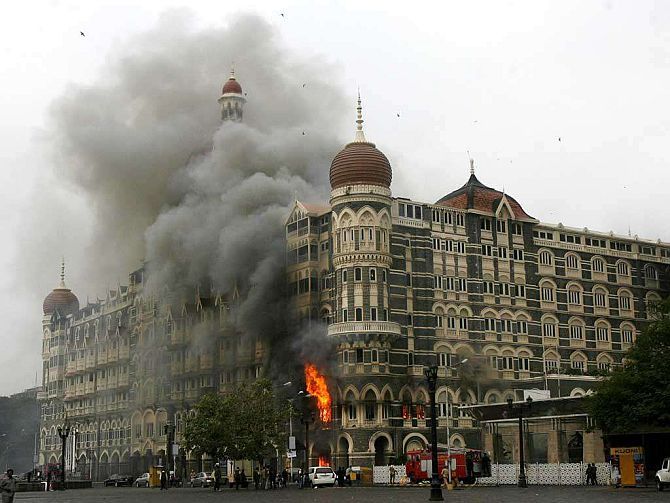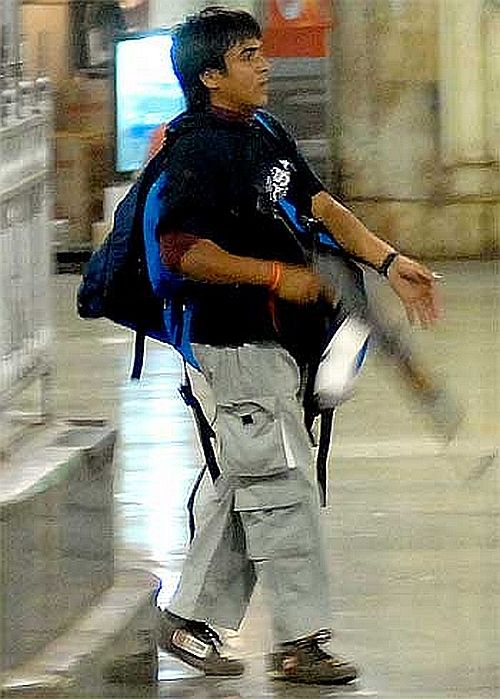'An operation such as the Mumbai attacks, which needed expert technical assessment, money and time to prepare, could not have been carried out without the knowledge of the ISI's leadership.'
Dr Hein G Kiessling -- who lived in Pakistan from 1989 to 2002 in Pakistan, including four years in Quetta and nine in Islamabad during which he forged close contacts with Pakistan's political, military and intelligence elite -- on the horrific November 2008 Mumbai terror attacks.
An exclusive excerpt from Dr Kessling's new book, Faith, Unity, Discipline: The ISI Of Pakistan.

On November 26, 2008, a 10-man terrorist commando landed on small boats in Mumbai to spread terror and death.
Their principal targets were two famous hotels, one of the city's major train stations and a Jewish centre.
At the end of 60 hours of continuous terror, there were 173 dead and numerous wounded.
Of the 10 terrorists, nine were killed and one, Ajmal Amir Kasab, from Pakistan's Punjab, was captured alive. He was later hanged.
His interrogation brought the first insights into the attack. All 10 perpetrators came from Pakistan, nine from Punjab and the leader from NWFP.
They were a Lashkar-e-Tayiba terrorist group, who had been trained and primed over months in two camps close to Muzaffarabad in Azad Kashmir and later in Karachi.
According to Kasab's statement, among the trainers were two former Pakistani military personnel.
Indian officials and experts quickly made it known that an operation of this magnitude could hardly have been planned, prepared and accomplished solely by LeT.
They pointed the finger at the ISI and the (then) Indian prime minister, Manmohan Singh, stated unequivocally on January 6, 2009, that 'there is enough evidence to show that, given the sophistication and the military precision of the attack, it must have had the support of some official agencies in Pakistan.'
The ISI added fuel to these suspicions.
As soon as the first pictures of the terrorists surfaced in the media, they tried to erase the traces.
The ISI turned up in Kasab's village of Faridkot, in Okara district and threatened his neighbours to swear silence. Kasab's parents also vanished from the village.
Just how much the ISI felt under pressure was visible in the subsequent weeks. It invited international journalists to the ISI headquarters to prove the alleged spuriousness of the accusations.
Director General ISI Lieutenant General Pasha, who had formerly been based in Germany for military training and spoke German, granted an exclusive interview to Der Spiegel, in which he denied all accusations against the secret service.
In the Pakistani press, articles and columns from commissioned writers were published, praising the agency and its role as the guarantor of Pakistan's security.
Simultaneously polemic statements about alleged atrocities carried out by India's R&AW surfaced on the Internet.
R&AW responded, and this led to a lively and interesting bout of psychological warfare between the two adversaries.

Any analysis of the Mumbai events must ask the question whether the leadership of the ISI and GHQ were informed beforehand about the planned terror attacks.
One answer common among writers on intelligence matters is the idea of 'an ISI within the ISI,' but the author thinks this is erroneous.
This phrase might have been deliberately created by the ISI itself.
Pakistan's prime intelligence service is a strictly led, efficiently run organisation, with no room for groups pursuing their own secret agenda.
An operation such as the Mumbai attacks, which needed expert technical assessment, money and time to prepare, could not have been carried out or kept hidden without the knowledge of the service's leadership.
Considering the political explosiveness of the event, the COAS as well would have to have been informed.
The government in Islamabad was not accused of co-conspiracy or of having prior knowledge of the Mumbai attack by New Delhi, so they opted for damage limitation.
As soon as the attacks became public knowledge, (Pakistan President Asif) Zardari and (Pakistan Prime Minister Yousaf Raza) Gilani spoke to their minister of foreign affairs, (Shah Mehmood) Qureshi, who happened to be in India.
He proposed to his Indian counterparts a visit by DG ISI Pasha to investigate the incident. But GHQ (Pakistan's army headquarters) and the ISI quickly put a stop to this: Qureshi was recalled and flew home on a PAF (Pakistan Air Force) plane that night.
The government now began to toe the military line: All allegations were denied, evidence demanded and reports and information from India were explained as insufficient.
Meanwhile the LeT was blacklisted, its offices closed and its bank accounts frozen.
Allegedly only that part of the organisation active in the social welfare was excluded, whereas all LeT base groups continue to have a free field of action.
A number of LeT cadres were arrested, among them the masterminds of the Mumbai attacks, Zakir-ur Rehman Lakhvi and Zarrah Shah.
During their interrogation, both spoke candidly about their role in the preparation of the terror atrocity, without regrets, without doubts.
Initially, seven LeT cadres faced prosecution under the Pakistan anti-terrorism act, to which two were later added.
Initially, the trial was closed. New Delhi realistically expects neither an accurate factual explanation of what occurred nor an appropriate sentence to be passed on its perpetrators.
In the US, India's battering coincided with the outgoing Bush government and the incoming Obama administration. They feared retaliatory strikes from India on Pakistan, in particular a real prospect of a bombing attack on the ISI HQ in Islamabad.
Senator John Kerry, designated chairman of the Senate Foreign Relations Committee, flew to New Delhi, tasked with the mission of persuading India to adopt a more prudent response. He promised future American intervention in South Asia politics in a manner that might satisfy Indian expectations.
In reply, India submitted intelligence data about the Mumbai attacks collated jointly between R&AW and the CIA.
Both services managed to obtain some of the intercepted communications between the terrorists and their backers.
As in the Kabul embassy bombings, the possibility of a forthcoming high profile attack was known beforehand, but not where and when it might take place.
Kerry's journey ultimately proved to be successful. New Delhi refrained from military retaliation. They decided to erect no additional hurdles for President Zardari, who was more appreciated in India than he was in Pakistan, and to see what the Obama administration's new policies towards Pakistan would bring.
Nearly a year after the Mumbai attacks, in October 2009, David Coleman Headley was arrested in the United States.
At birth, the Washington-born US citizen was known as Daqood Sayed Gilani but used his new Western name to erase his Pakistani roots and links to LeT.
For Headley, it proved straightforward to travel five times to India, carrying a US passport with a business visa and to obtain local information for LeT before the planned outrage.
During his interrogation he gave details of 26/11, as the Mumbai attack came to be known.
According to Headley, the ISI was in constant contact with LeT over the preparations for Mumbai, at each and every stage of the operation.
In addition, the ISI had prepared a list of four or five Al Qaeda members who they were to put in the frame as potential suspects involved in the attacks.
This plan failed largely because of the self-confidence of the LeT leadership: They envisioned global interest in the 26/11 terror acts, which they regarded almost as a marketing opportunity for their brand of terrorism, an event that would help them obtain further financial assistance and recruit new fighters.
Excerpted from Faith, Unity, Discipline: The ISI Of Pakistan by Dr Hein G Kiessling, with the permission of the publishers, HarperCollins India.










